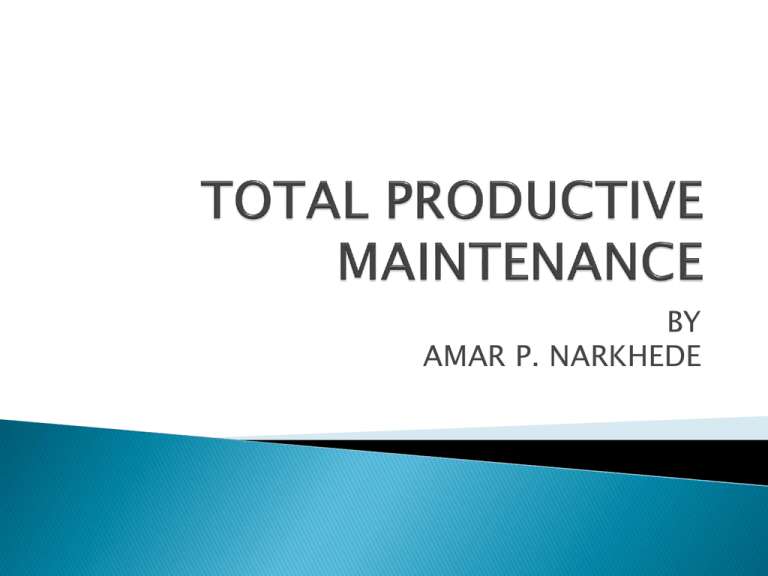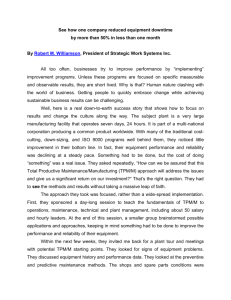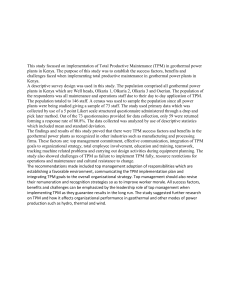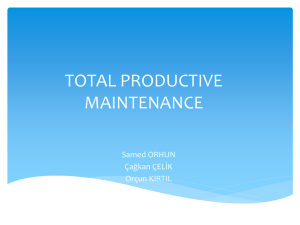total productive maintenance ppt
advertisement

BY AMAR P. NARKHEDE TPM based on zero loss concept, zero accidents, zero defects and zero breakdowns which renders equipments highly effective Total productive maintenance Aims at getting efficient use of equipments means overall efficiency Promotes and implements productive maintenance through group or team activities TPM is deployed through a unique 8 pillar approach for easy deployment in any industry at any age 1. 2. 3. 4. 5. 6. 7. 8. Autonomous maintenance (JISHU-HOZEN) KOBETSU- KAIZEN Planned maintenance Quality maintenance Maintenance prevention and equipment initial control Education and training Safety health and environment Office TPM Autonomous maintenance (JISHU-HOZEN) Autonomous maintenance is the cleaning, checking, discovering hidden faults and undertaking simple adjustments by operators, systematically trained through a step by step program. Autonomous management is to prevent reoccurrence of defects by taking preemptive action by the operator. This is my machine and must maintain it this should be the attitude of every operator Kobetsu- kaizen: It is continuously improve workers, equipments and material through continuous improvement in the process and procedure. It analyses various causes of time losses and evolves solutions to chronic problems like Breakdown losses Setup and adjustment losses Speed losses Quality defects and rework loss Start up losses Benefits of Kobetsu Kaizen 1. Equipment failures 2. Equipment breakdowns 3. Job change time 4. Tool change time 5. Minor stops 6. Management losses a. want of operators b. want of tools materials 7. Manufacturing costs Planned maintenance: Planned maintenance is to achieve zero breakdown by improving the efficiency of traditional preventive maintenance activities Planned maintenance aims at a. Focusing on planned maintenance rather than breakdown maintenance b. Achieving autonomous maintenance c. Supporting autonomous maintenance d. Increasing meantime between failure MTBF e. Reducing maintenance cost Quality maintenance: Quality maintenance is to prevent defects in quality by a. Incorporating quality into products through process and equipment rather than controlling quality by inspecting products and taking action against defects after they have occurred b. Maintaining perfect machine and tooling conditions so that defects are not produced c. Setting and maintaining optimal process conditions to get quality products d. Preventing occurrence of defects by periodic measurements and verification of standards e. Taking counter measures Maintenance prevention design and initial equipment control: M.P. design and initial equipment control is designed to facilitate a. Most efficient equipment investment aimed at achieving a vertical start upon full production b. Design of equipment which is functional, easy and which does not fail c. Shorten the period of development d. Achieve low life cycle of equipment Education and Training: It is the one of the important pillar of TPM since success of TPM depends on the Education and Training. The aim of education and Training is a. To develop talent in equipment maintenance and operation b. To develop skills for zero defects, zero break down and zero accidents c. To develop abilities to discover and analyze malfunctions and improve equipment functioning d. To have multi-skilled employees in all department Office TPM: Office TPM is to eliminate problems in the non stop floor activity so that offices are oriented for excellent support for manufacturing. Typical office problems analysis under office TPM are: non availability of files/documents in time, lengthy meeting without agenda, poor housekeeping, insufficient storage, high inventory, slow manual working, duplicate work. TPM aims at: a. Improvement in the filing system b. Paperless working c. Office automation d. Reduction in product inventory e. Increase in office productivity f. Speedy communication Safety, hygiene and environment control: Safety, hygiene and environment control is to identify and eliminate all hazards by adopting safe, hygiene and environment friendly activities to prevent death, disability, injuries and occupational diseases at work TPM is one of the best tools to enhance safety and environment at the work place through small group activities and involvement at all levels of the organization for the common goal of zero accidents and zero pollution TPM aims at a. Zero accidents b. Zero occupational disease c. Zero pollution Declaration by top management to introduce TPM Introductory education and campaign for TPM Create organizations to promote TPM Setting basic policy and targets for TPM Preparation of master plan for implementing TPM TPM kicks off projects in the organization Steps 7 to 11 implementation of all 8 TPM pillars Total application of TPM and raising its level Greater equipment availability Low production cost Development of employees Great employee involvement due to small group activities Improved quality Few customers complaints THANK YOU











